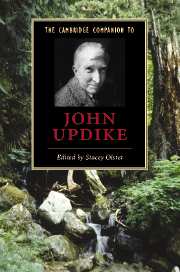Book contents
- Frontmatter
- Introduction: “A sort of helplessly 50’s guy”
- Part I Early influences and recurrent concerns
- 1 Updike, middles, and the spell of “subjective geography”
- 2 “Nakedness” or realism in Updike’s early short stories
- 3 Updike, religion, and the novel of moral debate
- Part II Controversy and difference
- Part III American chronicles
- Conclusion: U(pdike) & P(ostmodernism)
- Select bibliography
- Index
1 - Updike, middles, and the spell of “subjective geography”
from Part I - Early influences and recurrent concerns
Published online by Cambridge University Press: 28 August 2006
- Frontmatter
- Introduction: “A sort of helplessly 50’s guy”
- Part I Early influences and recurrent concerns
- 1 Updike, middles, and the spell of “subjective geography”
- 2 “Nakedness” or realism in Updike’s early short stories
- 3 Updike, religion, and the novel of moral debate
- Part II Controversy and difference
- Part III American chronicles
- Conclusion: U(pdike) & P(ostmodernism)
- Select bibliography
- Index
Summary
When I write, I aim in my mind . . . toward a vague spot a little to the east of Kansas.
– John Updike in a 1968 interview with Charles Thomas SamuelsSetting is never merely background in John Updike's fiction. His characters are so intertwined with their settings that their very identities adhere to certain places. Updike's subject matter has ranged considerably across time (in historical works like In the Beauty of the Lilies [1996] and futuristic works like Toward the End of Time [1997]) and place (Africa in The Coup [1978], the Soviet Union in Bech: A Book [1970], and Brazil in Brazil [1994]). Yet he is often associated with middles, especially the mid-Atlantic region, home to the American middle class. His relationship to his boyhood in small-town Shillington, Pennsylvania, in particular, has had a profound and enduring impact on his development and on his reputation. Shillington is the origin of his conception of “middleness,” and this particular setting is linked to his art in tangible ways. In his 1962 memoir “The Dogwood Tree: A Boyhood” he writes, “To transcribe middleness with all its grits, bumps, and anonymities, in its fullness of satisfaction and mystery: is it possible or, in view of the suffering that violently colors the periphery and that at all moments threatens to move into the center, worth doing? Possibly not; but the horse-chestnut trees, the telephone poles, the porches, the green hedges recede to a calm point that in my subjective geography is still the center of the world.”
- Type
- Chapter
- Information
- The Cambridge Companion to John Updike , pp. 15 - 28Publisher: Cambridge University PressPrint publication year: 2006
- 2
- Cited by

